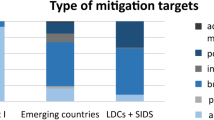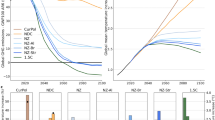Abstract
The Paris Agreement culminates a six-year transition towards an international climate policy architecture based on parties submitting national pledges every five years1. An important policy task will be to assess and compare these contributions2,3. We use four integrated assessment models to produce metrics of Paris Agreement pledges, and show differentiated effort across countries: wealthier countries pledge to undertake greater emission reductions with higher costs. The pledges fall in the lower end of the distributions of the social cost of carbon and the cost-minimizing path to limiting warming to 2 °C, suggesting insufficient global ambition in light of leaders’ climate goals. Countries’ marginal abatement costs vary by two orders of magnitude, illustrating that large efficiency gains are available through joint mitigation efforts and/or carbon price coordination. Marginal costs rise almost proportionally with income, but full policy costs reveal more complex regional patterns due to terms of trade effects.
This is a preview of subscription content, access via your institution
Access options
Subscribe to this journal
Receive 12 print issues and online access
$209.00 per year
only $17.42 per issue
Buy this article
- Purchase on Springer Link
- Instant access to full article PDF
Prices may be subject to local taxes which are calculated during checkout



Similar content being viewed by others
References
Keohane, R.O. & Victor, D. G. Cooperation and discord in global climate policy. Nat. Clim. Change 6, 570–575 (2016).
Aldy, J. E. & Pizer, W. A. Alternative metrics for comparing domestic climate change mitigation efforts and the emerging international climate policy architecture. Rev. Environ. Econ. Policy 10, 3–24 (2016).
Aldy, J. E., Pizer, W. A. & Akimoto, K. Comparing emissions mitigation efforts across countries. Clim. Policy 1–15 (2016).
Schelling, T. C. An essay on bargaining. Am. Econ. Rev. 46, 281–306 (1956).
Chayes, A. & Chayes, A. H. Compliance without enforcement: state behavior under regulatory treaties. Negotiation J. 7, 311–330 (1991).
Barrett, S. Environment and statecraft: the strategy of environmental treaty-making. Manag. Environ. Qual. 14, 622–623 (2003).
Bodansky, D., Brunnée, J. & Hey, E. The Oxford Handbook of International Environmental Law (Oxford Univ. Press, 2007).
Victor, D. G. in Architectures for Agreement: Addressing Global Climate Change in the Post-Kyoto World (eds Stavins, R. N. & Aldy, J. E.) 133–172 (Cambridge Univ. Press, 2007).
Pizer, W. A. in Architectures for Agreement: Addressing Global Climate Change in the Post-Kyoto World (eds Stavins, R. N. & Aldy, J. E.) 280–314 (Cambridge Univ. Press, 2007).
Ostrom, E. A behavioral approach to the rational choice theory of collective action: presidential address, American Political Science Association, 1997. Am. Political Sci. Rev. 92, 1–22 (1998).
den Elzen, M. G. J., Hof, A. F. & Roelfsema, M. The emission gap between the Copenhagen pledges and the 2 °C climate goal: options for closing and risks that could widen the gap. Glob. Environ. Change 21, 733–743 (2011).
The Emission Gap Report 2010: Are the Copenhagen Pledges Sufficient to Limit Global Warming to 2 °C or 1.5 °C? (UN Environment Programme, 2010).
Thompson, A. Management under anarchy: the international politics of climate change. Climatic Change 78, 7–29 (2006).
Aldy, J. E. The crucial role of policy surveillance in international climate policy. Climatic Change 126, 279–292 (2014).
Aldy, J. E. in Handbook on Energy and Climate Change (ed. Fouquet, R.) 352–374 (Elgar, 2012).
Manne, A., Mendelsohn, R. & Richels, R. MERGE. Energy Policy 23, 17–34 (1995).
Aldy, J. E. Evaluating Mitigation Effort: Tools and Institutions for Assessing Nationally Determined Contributions (Harvard Project on Climate Agreements, 2015).
Houser, T. Copenhagen, the Accord, and the way Forward (Peterson Institute for International Economics, 2010).
Dellink, R., Briner, G. & Clapp, C. Costs, Revenues, and Effectiveness of the Copenhagen Accord Emission Pledges for 2020 (OECD, 2010).
McKibbin, W. J., Morris, A. C. & Wilcoxen, P. J. Comparing climate commitments: a model-based analysis of the Copenhagen Accord. Climate Change Economics 2, 79–103 (2011).
Clarke, L. et al. International climate policy architectures: overview of the EMF 22 International Scenarios. Energy Econ. 31, S64–S81 (2009).
Kriegler, E., Tavoni, M., Riahi, K. & vanVuuren, D. P. Introducing the limits special issue. Clim. Change Econ. 4, 1302002 (2013).
Kriegler, E. et al. Making or breaking climate targets: the AMPERE study on staged accession scenarios for climate policy. Technol. Forecast. Soc. Change 90, 24–44 (2015).
Tavoni, M. et al. Post-2020 climate agreements in the major economies assessed in the light of global models. Nat. Clim. Change 5, 119–126 (2015).
Fawcett, A. A. et al. Can Paris pledges avert severe climate change? Science 350, 1168–1169 (2015).
Cai, Y., Judd, K. L. & Lontzek, T. S. The social cost of carbon with economic and climate risks. Preprint at http://arxiv.org/abs/1504.06909 (2015).
Stern, D. I., Pezzey, J. C. V. & Lambie, N. R. Where in the world is it cheapest to cut carbon emissions? Aust. J. Agric. Resour. Econ. 56, 315–331 (2012).
Bodansky, D. M., Hoedl, S. A., Metcalf, G. E. & Stavins, R. N. Facilitating linkage of climate policies through the Paris outcome. Clim. Policy 1–17 (2015).
Cooper, R. in Post-Kyoto International Climate Policy: Implementing Architectures for Agreement (eds Stavins, R. N. & Aldy, J. E.) 151–78 (Cambridge Univ. Press, 2010).
Akimoto, K. et al. Comparison of marginal abatement cost curves for 2020 and 2030: longer perspectives for effective global GHG emission reductions. Sustain. Sci. 7, 157–168 (2012).
Akimoto, K. et al. Estimates of GHG emission reduction potential by country, sector, and cost. Energy Policy 38, 3384–3393 (2010).
Joint Global Change Research Institute Global Change Assessment Model v. 4.2 (Pacific Northwest National Laboratory, 2015); http://www.globalchange.umd.edu/archived-models/gcam/download
Blanford, G., Merrick, J., Richels, R. & Rose, S. Trade-offs between mitigation costs and temperature change. Climatic Change 123, 527–541 (2014).
Bosetti, V., Carraro, C., Galeotti, M., Massetti, E. & Tavoni, M. WITCH: A world induced technical change hybrid model. Energy J. 27, 13–38 (2006).
Technical Support Document: Technical Update of the Social Cost of Carbon for Regulatory Analysis Under Executive Order 12866 (US Environmental Protection Agency, 2015).
Council of Economic Advisers Economic Report of the President (US Government Publishing Office, 2016).
Acknowledgements
The Research Institute of Innovative Technology for the Earth provided financial support for this project. L.E.C., J.E., G.C.I. and H.C.M. were supported by the Global Technology Strategy Project. The views expressed here reflect those of the individual authors and not necessarily those of EPRI or its members.
Author information
Authors and Affiliations
Contributions
J.A., K.A., W.P. and M.T. were responsible for project planning and scenario design. K.A., L.A.R., G.B., C.C., L.E.C., J.E., G.C.I., H.C.M., R.R., S.R., F.S. and M.T. contributed to the modelling results. J.A., L.A.R., W.P. and M.T. undertook the synthesis of the analyses. J.A., W.P. and M.T. drafted the paper.
Corresponding author
Ethics declarations
Competing interests
The authors declare no competing financial interests.
Rights and permissions
About this article
Cite this article
Aldy, J., Pizer, W., Tavoni, M. et al. Economic tools to promote transparency and comparability in the Paris Agreement. Nature Clim Change 6, 1000–1004 (2016). https://doi.org/10.1038/nclimate3106
Received:
Accepted:
Published:
Issue Date:
DOI: https://doi.org/10.1038/nclimate3106
This article is cited by
-
Mobilizing non-state actors for climate action through the global stocktake
Nature Climate Change (2023)
-
Evaluating pollution damage function through carbon pricing, renewable energy demand, and cleaner technologies in China: blue versus green economy
Environmental Science and Pollution Research (2022)
-
Increasing the ambition of the EU Nationally Determined Contribution: lessons from a survey of experts and students
Economia Politica (2022)
-
Policy assessments for the carbon emission flows and sustainability of Bitcoin blockchain operation in China
Nature Communications (2021)
-
A multi-model analysis of long-term emissions and warming implications of current mitigation efforts
Nature Climate Change (2021)



